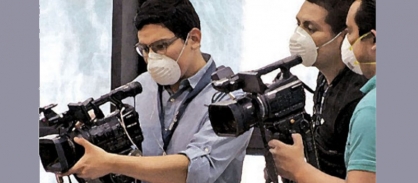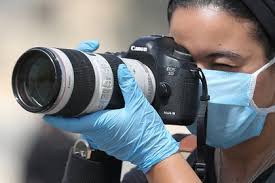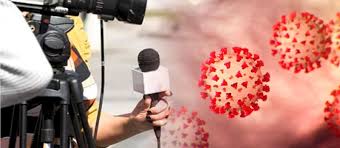In this river of streets and bridges

The role of the media in the information coverage of the pandemic
Felipe de J. Monroy *
First, the scenario: Two reporters have been stationed for entire days outside the hospital that receives patients with symptoms of COVID-19. Until now they have achieved little but useful: some stories of the relatives who have brought their loved ones, their diverse origins, their particular challenges, their fears and hopes in the face of the disease of which only everything that we do not know is known with certainty. The edited pieces are broadcast on the nightly newscast and show an immense audience “the human part” that the figures and statistics of the coronavirus pandemic are not enough to move us. Unfortunately, we, like them, quickly forget the names of the interviewees from the night before and we will hurt again with each new story they present.
Far from there, thousands of data from public and private institutions on coronavirus infections are compiled in the health ministry offices; they are organized, interpreted and plotted. The social communication office collaborates with the experts so that the tables and statistics are correctly presented to the media that await timely updates on the pace of the pandemic in the country. These employees will do this work endlessly, uninterruptedly, in an almost hypnotic cycle and an agonizing indefinite horizon. Your work is useful; it is evidenced rewarded when it is released immediately to give a photograph of society in the midst of the pandemic.

Second, the language: Hundreds of journalists and news presenters, after receiving institutional data on the development of the health crisis, transmit it to their audiences trying not to be alarmist, but neither distracted nor frivolous. Professional ethics recommends reporting these data with a voice that balances honest concern matured with courage, moderation, certainty, and trust; and, if possible, a pinch of hope. However, the producers of the newscast, the marketing department or the board of directors have already suggested the tone of the information. They opt for the easy and the attractive: scaremongering and the recurrent warlike language.
For whatever reason, almost no media outlet can resist the language of war or military terminology. Journalists in the midst of coverage of the pandemic call the hospitals 'front line, war front or trench'; 'casualties' to those killed by COVID or 'war report' to the statistical compendium of medical incidents due to the virus. Some news anchors do not blush when they call the secretary or minister of health a 'commander' or 'general'; they describe the SARS-Cov2 coronavirus as 'the enemy' or 'the invader'; and they say 'combat uniform' to refer to the health protection equipment of medical personnel. On every website, newscast, or print newsletter we see the same trend: onslaught, battle, danger radius, collateral effects, capitulation, strategy, deployment, command center, and so on.
The issue is not minor because we know very well that expressions in the media influence the understanding that audiences (and in the end, citizens) have of reality and their attitude towards it, as James Currán rightly states in ' Media and power in a democratic society '.
And third, the service. During the pandemic, all the news, at all times, update the figures and hard data of the complex phenomenon: the number of infections, the deceased, the saturation of the health system or funeral homes, those who have reached hospital service and those who no. Information that is important, but is it useful? That is, does it have a practical, immediate, reasonable and affordable utility for the population?

In the first moments of a global crisis, the speed and accumulation of events do not give respite to the media, nor do they give respite to their readers who are saturated with data and more data. When the crisis subsides - or the gaze reaches another perspective - the news programs remember one of their main functions: to help their audiences, to serve the community.
That is, when the stories and data about COVID crossed the media frontier and began to be part of the daily lives of most people, journalism was still able to rise from the noise and offer a vital service: orienting people on preventive health measures; help to recognize the symptoms and explain the mechanisms to answer questions or emergencies in the event of a possible case of COVID; highlight the most vulnerable or contagious regions, neighborhoods or neighborhoods; share spaces of saturation or hospital availability; counteract superstitions, fallacies, and false news; and, primarily, in the period of gradual resumption of activities, inform about schedules, staggered closings, capacity limits in establishments, digital or telephone resources to traditional services, virtual school activities and a long etcetera.
These three elements (setting, language and service) are an essential minimum to understand the role of the media during the pandemic and throughout the effects it has unleashed on all human activity: report a scenario, choose a language and offer a service.
In an extreme reduction, journalism is an activity that, seeking the truth, serves the public good when it reaches people in their reality and context. The media knows that their content must mean something to someone somewhere and for a reason. Good journalism informs of the reality in the individual and the community; His trade and profession also helps with his language in the particular dimension of our life and in our social context; and, finally, it helps us build trust, hope, and compassion for others. Its reverse, on the contrary, distorts reality, perverts language and sows fear and hatred.
It seems too heavy on the shoulders of those who carry the humble profession of everyday storytellers, of historians of the immediate. However, this is the river of streets and bridges that journalists, communicators and anonymous communication servants cross in an infinite network of cities, towns and communities that demand to know, understand and assimilate; especially in such a difficult and complex time. The COVID pandemic - it has been said abundantly - took humanity by surprise, revealed our shortcomings and made us look back at the very nature of our human essence and our societies. A reality wounded by a new disease, yes, but also by fear, uncertainty, ignorance, isolation, distance, deception, miracle workers, the usual indolence. For the informative coverage of this reality, it is essential to insist on three values of communication: encounter, service and transforming potential.
From corners to bridges: Communication as an encounter
When the pandemic hit us like a storm, journalists - along with many other indispensable actors of the emergency - took to the streets to try to meet with people and institutions to inquire about reality, to find profiles of the truth by sharing their stories. and your needs. Communication in journalism is always a double encounter: one that seeks and another that delivers information; and both are encounters with a sense of public service.
But that is not all, whether on the data superhighway or in the small poorly lit peripheral alleys where millions of human beings pass, journalists can also choose two ways to meet reality in this informative river: by contingency, after meeting in a corner; or by way of certainty, when crossing a bridge. In any case, there are lights and shadows in each option that we must reflect on.
News coverage that opts for the chance and luck of bumping into what jumps around the corner is not inherently negative. In fact, the 'journalistic nose' is a desirable quality that seems to synthesize that capacity that the information professional has to distinguish between the subtleties and apparent trivialities of everyday life, stories of enormous relevance and social interest.
It happened with the case of Jesús Villavicencio, a peasant in Mexico, who took his wife to a public hospital to be treated for COVID-19. The journalists met him and many other relatives waiting for news of their loved ones outside the hospital. Villavicencio's case, however, drew attention because the state hospital issued him a bill of almost one million Mexican pesos ($ 57,000) for medical care for his wife.
The story became relevant since the public health system of the Mexican State had guaranteed gratuity to all people who required services for COVID care; However, the hospital authorities argued that the peasant's wife had entered the State of Mexico hospital without being a beneficiary and posing as a relative who did have medical services at that institution. Therefore, they had to charge them for all services. Deep down, however, the health authorities seemed to clarify that if Villavicencio and his wife had not lied, the hospital would never have received them and the woman would not have received any care or survived.
That is to say: the surprise meeting in an information corner was helpful in bringing to the social debate some ethical, political and institutional concerns that should be addressed during the health emergency. And that is good journalism.
But the unexpected encounter also has its dark face. Journalists and the media are not exempt from fear and prejudice. There are realities that suddenly overtake us in the corners that we do not want to reach and that fear can fill our eyes with suspicion and mistrust. The encounter, therefore, is born between fear and rejection; and when sharing it, many times it is loaded with contempt. An example of this happens, unfortunately, with migration.
That is why the meeting by the bridge is important. Perhaps the most recurrent metaphor is that communication must build bridges; journalists, therefore, must walk them. The journalist's service to society implies going through those links created especially with government institutions.
The information coverage during the pandemic requires us to constantly go through these connections and strengthen the link with trust and professionalism between society and authorities, especially with health agencies, ministries of health and authorized experts in the field. In practically all nations, a permanent communication and dialogue table was set up between the official health system and the media to update data and profiles of public interest on the pandemic. Similarly, secretaries, ministers or authorities responsible for health in the nations opened daily spaces to appear before the media. Thus, doctors and epidemiologists who lead the strategies of each country jumped to the knowledge of the public arena and, in an unprecedented way, many political figures were forced to give them the spotlight.
The daily monitoring of the information of course helps the authorities to disseminate with certainty the data of national or regional interest. It is an indispensable bridge to travel between the journalist and the official information; But, as we mentioned at the beginning, journalism is a double encounter: one that seeks information and another that takes it where it is needed. And this bridge should not be overlooked. The encounter with society and its demands, with its need to put the pandemic phenomenon in true perspective, is a bridge that must be used as much or more frequently than the one created by the authorities. They are less comfortable bridges, more difficult to cross, but irreplaceable.

Traffic lights and alleys: Communication as a service
Amid the chaos, news coverage of the pandemic has always sought a certain order: What is urgent? What is the essential? What is the immediate? What requires tempering before going on the air? What is better not to disclose? Who do you report to and why?
In the intense traffic of news, journalism must recognize the information traffic lights that must be prioritized and weighted in its service to reach audiences. Thus, objective data on prevention and care measures must always have the green light to get where it is required, to advance to the last corners of society. Dramatic stories or supposed institutional successes must cool down in the inexcusable verification process before being shared or not. And finally, there are voices and ideas that should never be stepped into: fake news, bigotry, blatant deception, or hate speech.
The pandemic, among many dire profiles, has shown us that the merchants of miracles lack all scruples to wrest their goods from people through strategies of fear and ignorance: without sustenance or science, COVID sparked 'entrepreneurs' with their thousands of supposed wonderful cures and protections, fantastic remedies for the worst of our fears. Journalism should not, even when the economic crisis seems to plunge it into famine, do a news coverage where the painful events of the pandemic are interspersed with commercials for miracle products that promise the impossible.
Perhaps the most delicate service of journalism in the pandemic has been precisely the verification of the information, the scientific validation of the arguments, the permanent contrast of the data against the skin of reality. Not all information should be passed on immediately, without context or validation; the traffic light for information coverage of the pandemic should be the most crowded: from 'herd immunity' to 'human testing of vaccines' to' epidemiological strategies' or 'fundraising campaigns for patients or relatives', all phenomena require cooling down, moving away from immediacy or alarmism. Verify, validate and weigh before disclosing.
And, of course, journalism is the service of delivering correct, accurate, and useful information. In almost all nations enjoying moderate press freedom, news coverage of the pandemic appears to have fulfilled this responsibility. There is usually only the risk of a self-indulgent mirage: communicating and informing 'everyone' could hide our lack of gaze and interest in informing 'the right ones'. It is well said that globalization does not exclude localization, it implies it. The information must be useful to the locality, the community, individuals and families who must live with the coronavirus, the pandemic, and the effects derived from it. Putting a green traffic light on the information highways does not replace the responsibility of entering those alleys and social nooks where the prodigies of globality and modernity do not arrive. In these corners live people who may urge them to understand a truth or two amid the chaos.
Beyond the walls: Communication for transformation
I have left the delicate matter of language at the end because in it not only the many substrates of our civilizational antecedents are condensed, but also the understanding of responsibility and freedom as two central dimensions of the human being in the construction of their relationships in reality. In other words, it reflects who we are and where we are going.
Language is also the raw material of journalists; and it is delicate that in a test as hard as the pandemic that challenges the systems and values of society, expressions of hatred, war and confrontation proliferate instead of those of solidarity, cooperation and integration.
The warlike language in the news coverage of the pandemic seems to call for walls - they would say 'trenches and barricades' - between the healthy and the sick, the civic and the irresponsible, the indispensable and the disposable. Heroes and villains appear in the social narrative. Absolute Manichaeism polarizes the attitude of citizens who have been inoculated with the idea and need for an 'enemy'. However, the "enemy" being invisible, has ended up materializing and personifying itself in the most diverse social sectors.
The World Medical Association, for example, was forced to condemn the unthinkable: the multiplication of physical attacks and violence committed against health personnel in various parts of the world. Doctors and other health personnel are stigmatized, marginalized, discriminated against and even physically attacked. But hundreds of social organizations have also denounced that with the pandemic persecution and contempt for migrants grew because the language of war has communicating vessels with xenophobia and racism: the 'others' are so different from 'us' that, in the crisis it is possible to segregate the 'different' to defend what is 'ours'.
Even in real war conflicts, it is desirable that journalistic coverage also opt for languages that make one understand the struggle with all the processes of decomposition along with what longs for peace, well-being and hope; and not only through the already anachronistic war correspondents who were limited to carrying with morbid and lewdness the horrors of combat. Therefore, in a global challenge that impacts all of humanity without distinction of peoples or nations, it is mandatory that journalists conduct their meeting service proposing a look and a language beyond tension, conflict, anger or death. .
The media in the pandemic have borne - perhaps without being fully aware of it - with the immense responsibility of participating almost exclusively in the formation and education of their societies and communities. Traditional educational processes are slow to adapt their content and objectives to the new reality; the intermediate institutions of society (labor and educational centers, religious communities, non-governmental organizations) were forced to close down and stay out of the crisis management; and, finally, the political authorities themselves have needed as much media coverage as possible to get their messages, instructions and indications to the population in response to the health emergency.
The reality is what it is. But even the objective reality is transformed through the actions that motivate our attitudes; and our attitudes are built from the emotions that the language of our daily life offers us. A negative emotional language configures distance and indolence that translate into walls and discrimination; on the contrary, a language that recognizes fraternity and hope is capable of transforming the hearts that post-pandemic humanity has to build.
One of these languages is found in the address of Pope Francis during the Urbi et Orbi blessing on March 27: “Like the disciples of the Gospel, we were surprised by an unexpected and furious storm. We realized that we were in the same boat, all fragile and disoriented; but, at the same time, important and necessary, all called to row together ”.
It is a language that forgets fortresses and walls, that is not afraid to admit that we suffer from the same storm and we go in a shared boat. A boat in which, in this vast river of streets and bridges, journalism and news coverage must recognize their role as a facilitator of encounter, of service; but primarily the responsibility of influencing society to achieve the transformation of their peoples, to help "regenerate beauty and revive hope."
* Journalist, communicator and consultant in communication strategies in Mexico, member of SIGNIS Mexico. Director VCNoticias.com
This article was published in the digital magazine Punto de Encuentro , of SIGNIS ALC, December 2020






